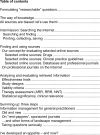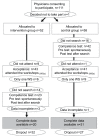A simple heuristic for Internet-based evidence search in primary care: a randomized controlled trial
- PMID: 27563264
- PMCID: PMC4984665
- DOI: 10.2147/AMEP.S78385
A simple heuristic for Internet-based evidence search in primary care: a randomized controlled trial
Abstract
Background: General practitioners (GPs) are confronted with a wide variety of clinical questions, many of which remain unanswered.
Methods: In order to assist GPs in finding quick, evidence-based answers, we developed a learning program (LP) with a short interactive workshop based on a simple three-step-heuristic to improve their search and appraisal competence (SAC). We evaluated the LP effectiveness with a randomized controlled trial (RCT). Participants (intervention group [IG] n=20; control group [CG] n=31) rated acceptance and satisfaction and also answered 39 knowledge questions to assess their SAC. We controlled for previous knowledge in content areas covered by the test.
Results: Main outcome - SAC: within both groups, the pre-post test shows significant (P=0.00) improvements in correctness (IG 15% vs CG 11%) and confidence (32% vs 26%) to find evidence-based answers. However, the SAC difference was not significant in the RCT.
Other measures: Most workshop participants rated "learning atmosphere" (90%), "skills acquired" (90%), and "relevancy to my practice" (86%) as good or very good. The LP-recommendations were implemented by 67% of the IG, whereas 15% of the CG already conformed to LP recommendations spontaneously (odds ratio 9.6, P=0.00). After literature search, the IG showed a (not significantly) higher satisfaction regarding "time spent" (IG 80% vs CG 65%), "quality of information" (65% vs 54%), and "amount of information" (53% vs 47%).
Conclusion: Long-standing established GPs have a good SAC. Despite high acceptance, strong learning effects, positive search experience, and significant increase of SAC in the pre-post test, the RCT of our LP showed no significant difference in SAC between IG and CG. However, we suggest that our simple decision heuristic merits further investigation.
Keywords: continuing medical education; decision making; evidence-based practice; medical informatics.
Figures





Similar articles
-
The effectiveness of internet-based e-learning on clinician behavior and patient outcomes: a systematic review protocol.JBI Database System Rev Implement Rep. 2015 Jan;13(1):52-64. doi: 10.11124/jbisrir-2015-1919. JBI Database System Rev Implement Rep. 2015. PMID: 26447007
-
Study protocol of a randomized controlled trial on two new dissemination strategies for a brief, shared-decision-making (SDM) training for oncologists: web-based interactive SDM online-training versus individualized context-based SDM face-to-face training.Trials. 2019 Jan 7;20(1):18. doi: 10.1186/s13063-018-3112-7. Trials. 2019. PMID: 30616653 Free PMC article.
-
Patient education programme on immunotherapy in multiple sclerosis (PEPIMS): a controlled rater-blinded study.Clin Rehabil. 2017 Feb;31(2):250-261. doi: 10.1177/0269215516639734. Epub 2016 Jul 10. Clin Rehabil. 2017. PMID: 27072153 Clinical Trial.
-
Screening for Cervical Cancer With High-Risk Human Papillomavirus Testing: A Systematic Evidence Review for the U.S. Preventive Services Task Force [Internet].Rockville (MD): Agency for Healthcare Research and Quality (US); 2018 Aug. Report No.: 17-05231-EF-1. Rockville (MD): Agency for Healthcare Research and Quality (US); 2018 Aug. Report No.: 17-05231-EF-1. PMID: 30256575 Free Books & Documents. Review.
-
Behavioral Counseling to Promote a Healthful Diet and Physical Activity for Cardiovascular Disease Prevention in Adults Without Known Cardiovascular Disease Risk Factors: Updated Systematic Review for the U.S. Preventive Services Task Force [Internet].Rockville (MD): Agency for Healthcare Research and Quality (US); 2017 Jul. Report No.: 15-05222-EF-1. Rockville (MD): Agency for Healthcare Research and Quality (US); 2017 Jul. Report No.: 15-05222-EF-1. PMID: 29364620 Free Books & Documents. Review.
References
-
- Covell DG, Uman GC, Manning PR. Information needs in office practice: are they being met? Ann Intern Med. 1985;103(4):596–599. - PubMed
-
- Ely JW, Burch RJ, Vinson DC. The information needs of family physicians: case-specific clinical questions. J Fam Pract. 1992;35(3):265–269. - PubMed
-
- Ely JW, Levy BT, Hartz A. What clinical information resources are available in family physicians’ offices? J Fam Pract. 1999;48(2):135–139. - PubMed
-
- Del Fiol, Guilherme, Workman TE, Gorman PN. Clinical questions raised by clinicians at the point of care: a systematic review. JAMA Intern Med. 2014;174(5):710–718. - PubMed
LinkOut - more resources
Full Text Sources
Other Literature Sources

